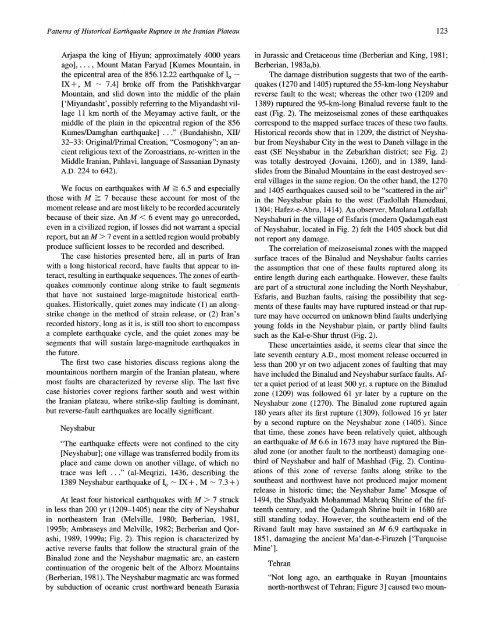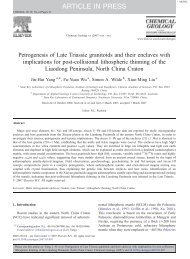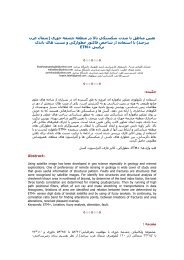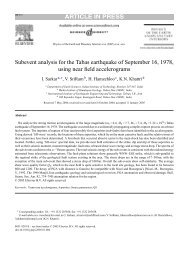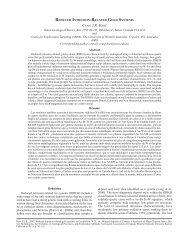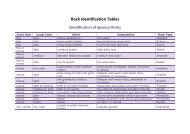Patterns of Historical Earthquake Rupture in the Iranian Plateau
Patterns of Historical Earthquake Rupture in the Iranian Plateau
Patterns of Historical Earthquake Rupture in the Iranian Plateau
- No tags were found...
You also want an ePaper? Increase the reach of your titles
YUMPU automatically turns print PDFs into web optimized ePapers that Google loves.
<strong>Patterns</strong> <strong>of</strong> <strong>Historical</strong> <strong>Earthquake</strong> <strong>Rupture</strong> <strong>in</strong> <strong>the</strong> <strong>Iranian</strong> <strong>Plateau</strong> 123Arjaspa <strong>the</strong> k<strong>in</strong>g <strong>of</strong> Hiyun; approximately 4000 yearsago] ..... Mount Matan Faryad [Kumes Mounta<strong>in</strong>, <strong>in</strong><strong>the</strong> epicentral area <strong>of</strong> <strong>the</strong> 856.12.22 earthquake <strong>of</strong> Io --IX +, M -- 7.4] broke <strong>of</strong>f from <strong>the</strong> PatishkhvargarMounta<strong>in</strong>, and slid down <strong>in</strong>to <strong>the</strong> middle <strong>of</strong> <strong>the</strong> pla<strong>in</strong>[’Miyandasht’, possibly referr<strong>in</strong>g to <strong>the</strong> Miyandasht village11 km north <strong>of</strong> <strong>the</strong> Meyamay active fault, or <strong>the</strong>middle <strong>of</strong> <strong>the</strong> pla<strong>in</strong> <strong>in</strong> <strong>the</strong> epicentral region <strong>of</strong> <strong>the</strong> 856Kumes/Damghan earthquake] ..." (Bundahishn, XII/32-33: Orig<strong>in</strong>al/Primal Creation, "Cosmogony"; an ancientreligious text <strong>of</strong> <strong>the</strong> Zoroastrians, re-written <strong>in</strong> <strong>the</strong>Middle <strong>Iranian</strong>, Pahlavi, language <strong>of</strong> Sassanian DynastyA.D. 224 to 642)."The earthquake effects were not conf<strong>in</strong>ed to <strong>the</strong> city[Neyshabur]; one village was transferred bodily from itsplace and came down on ano<strong>the</strong>r village, <strong>of</strong> which notrace was left ..." (al-Meqrizi, 1436, describ<strong>in</strong>g <strong>the</strong>1389 Neyshabur earthquake <strong>of</strong> I o -- IX +, M - 7.3 + )At least four historical earthquakes with M > 7 struck<strong>in</strong> less than 200 yr (1209-1405) near <strong>the</strong> city <strong>of</strong> Neyshabur<strong>in</strong> nor<strong>the</strong>astern Iran (Melville, 1980; Berberian, 1981,1995b; Ambraseys and Melville, 1982; Berberian and Qorashi,1989, 1999a; Fig. 2). This region is characterized byactive reverse faults that follow <strong>the</strong> structural gra<strong>in</strong> <strong>of</strong> <strong>the</strong>B<strong>in</strong>alud zone and <strong>the</strong> Neyshabur magmatic arc, an easterncont<strong>in</strong>uation <strong>of</strong> <strong>the</strong> orogenic belt <strong>of</strong> <strong>the</strong> Alborz Mounta<strong>in</strong>s(Berberian, 1981). The Neyshabur magmatic arc was formedby subduction <strong>of</strong> oceanic crust northward beneath Eurasia<strong>in</strong> Jurassic and Cretaceous time (Berberian and K<strong>in</strong>g, 1981;Berberian, 1983a,b).The damage distribution suggests that two <strong>of</strong> <strong>the</strong> earthquakes(1270 and 1405) ruptured <strong>the</strong> 55-km-long Neyshaburreverse fault to <strong>the</strong> west; whereas <strong>the</strong> o<strong>the</strong>r two (1209 and1389) ruptured <strong>the</strong> 95-km-long B<strong>in</strong>alud reverse fault to <strong>the</strong>east (Fig. 2). The meizoseismal zones <strong>of</strong> <strong>the</strong>se earthquakescorrespond to <strong>the</strong> mapped surface traces <strong>of</strong> <strong>the</strong>se two faults.<strong>Historical</strong> records show that <strong>in</strong> 1209, <strong>the</strong> district <strong>of</strong> Neyshaburfrom Neyshabur City <strong>in</strong> <strong>the</strong> west to Daneh village <strong>in</strong> <strong>the</strong>east (SE Neyshabur <strong>in</strong> <strong>the</strong> Zebarkhan district; see Fig. 2)was totally destroyed (Jova<strong>in</strong>i, 1260), and <strong>in</strong> 1389, landslidesfrom <strong>the</strong> B<strong>in</strong>alud Mounta<strong>in</strong>s <strong>in</strong> <strong>the</strong> east destroyed severalvillages <strong>in</strong> <strong>the</strong> same region. On <strong>the</strong> o<strong>the</strong>r hand, <strong>the</strong> 1270and 1405 earthquakes caused soil to be "scattered <strong>in</strong> <strong>the</strong> air"<strong>in</strong> <strong>the</strong> Neyshabur pla<strong>in</strong> to <strong>the</strong> west (Fazlollah Hamedani,1304; Hafez-e-Abru, 1414). An ob server, Maulana LotfallahWe focus on earthquakes with M _--> 6.5 and especiallythose with M _--> 7 because <strong>the</strong>se account for most <strong>of</strong> <strong>the</strong>moment release and are most likely to be recorded accuratelybecause <strong>of</strong> <strong>the</strong>ir size. An M < 6 event may go unrecorded, Neyshaburi <strong>in</strong> <strong>the</strong> village <strong>of</strong> Esfaris (modern Qadamgah easteven <strong>in</strong> a civilized region, if losses did not warrant a special <strong>of</strong> Neyshabur, located <strong>in</strong> Fig. 2) felt <strong>the</strong> 1405 shock but didreport, but an M > 7 event <strong>in</strong> a settled region would probably not report any damage.produce sufficient losses to be recorded and described.The correlation <strong>of</strong> meizoseismal zones with <strong>the</strong> mappedThe case histories presented here, all <strong>in</strong> parts <strong>of</strong> Iran surface traces <strong>of</strong> <strong>the</strong> B<strong>in</strong>alud and Neyshabur faults carrieswith a long historical record, have faults that appear to <strong>in</strong>teract,result<strong>in</strong>g <strong>in</strong> earthquake sequences. The zones <strong>of</strong> earth-entire length dur<strong>in</strong>g each earthquake. However, <strong>the</strong>se faults<strong>the</strong> assumption that one <strong>of</strong> <strong>the</strong>se faults ruptured along itsquakes commonly cont<strong>in</strong>ue along strike to fault segments are part <strong>of</strong> a structural zone <strong>in</strong>clud<strong>in</strong>g <strong>the</strong> North Neyshabur,that have not susta<strong>in</strong>ed large-magnitude historical earthquakes.<strong>Historical</strong>ly, quiet zones may <strong>in</strong>dicate (1) an alongments<strong>of</strong> <strong>the</strong>se faults may have ruptured <strong>in</strong>stead or that rup-Esfaris, and Buzhan faults, rais<strong>in</strong>g <strong>the</strong> possibility that segstrikechange <strong>in</strong> <strong>the</strong> method <strong>of</strong> stra<strong>in</strong> release, or (2) Iran’s ture may have occurred on unknown bl<strong>in</strong>d faults underly<strong>in</strong>grecorded history, long as it is, is still too short to encompass young folds <strong>in</strong> <strong>the</strong> Neyshabur pla<strong>in</strong>, or partly bl<strong>in</strong>d faultsa complete earthquake cycle, and <strong>the</strong> quiet zones may be such as <strong>the</strong> Kal-e-Shur thrust (Fig. 2).segments that will susta<strong>in</strong> large-magnitude earthquakes <strong>in</strong> These uncerta<strong>in</strong>ties aside, it seems clear that s<strong>in</strong>ce <strong>the</strong><strong>the</strong> future.late seventh century A.D., most moment release occurred <strong>in</strong>The first two case histories discuss regions along <strong>the</strong> less than 200 yr on two adjacent zones <strong>of</strong> fault<strong>in</strong>g that maymounta<strong>in</strong>ous nor<strong>the</strong>rn marg<strong>in</strong> <strong>of</strong> <strong>the</strong> <strong>Iranian</strong> plateau, where have <strong>in</strong>cluded <strong>the</strong> B<strong>in</strong>alud and Neyshabur surface faults. Aftera quiet period <strong>of</strong> at least 500 yr, a rupture on <strong>the</strong> B<strong>in</strong>aludmost faults are characterized by reverse slip. The last fivecase histories cover regions far<strong>the</strong>r south and west with<strong>in</strong> zone (1209) was followed 61 yr later by a rupture on <strong>the</strong><strong>the</strong> <strong>Iranian</strong> plateau, where strike-slip fault<strong>in</strong>g is dom<strong>in</strong>ant, Neyshabur zone (1270). The B<strong>in</strong>alud zone ruptured aga<strong>in</strong>but reverse-fault earthquakes are locally significant.180 years after its first rupture (1309), followed 16 yr laterby a second rupture on <strong>the</strong> Neyshabur zone (1405). S<strong>in</strong>ceNeyshaburthat time, <strong>the</strong>se zones have been relatively quiet, althoughan earthquake <strong>of</strong> M 6.6 <strong>in</strong> 1673 may have ruptured <strong>the</strong> B<strong>in</strong>aludzone (or ano<strong>the</strong>r fault to <strong>the</strong> nor<strong>the</strong>ast) damag<strong>in</strong>g onethird<strong>of</strong> Neyshabur and half <strong>of</strong> Mashhad (Fig. 2). Cont<strong>in</strong>uations<strong>of</strong> this zone <strong>of</strong> reverse faults along strike to <strong>the</strong>sou<strong>the</strong>ast and northwest have not produced major momentrelease <strong>in</strong> historic time; <strong>the</strong> Neyshabur Jame’ Mosque <strong>of</strong>1494, <strong>the</strong> Shadyakh Mohammad Mahruq Shr<strong>in</strong>e <strong>of</strong> <strong>the</strong> fifteenthcentury, and <strong>the</strong> Qadamgah Shr<strong>in</strong>e built <strong>in</strong> 1680 arestill stand<strong>in</strong>g today. However, <strong>the</strong> sou<strong>the</strong>astern end <strong>of</strong> <strong>the</strong>Rivand fault may have susta<strong>in</strong>ed an M 6.9 earthquake <strong>in</strong>1851, damag<strong>in</strong>g <strong>the</strong> ancient Ma’dan-e-Firuzeh [’TurquoiseM<strong>in</strong>e’].Tehran"Not long ago, an earthquake <strong>in</strong> Ruyan [mounta<strong>in</strong>snorth-northwest <strong>of</strong> Tehran; Figure 3] caused two moun-


